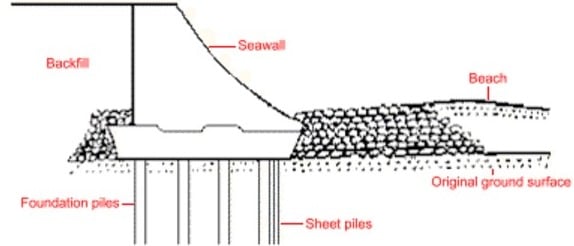The Main Principles Of Shore Protect Team
Wiki Article
What Does Shore Protect Team Mean?
Table of ContentsWhat Does Shore Protect Team Do?Indicators on Shore Protect Team You Should KnowShore Protect Team Fundamentals ExplainedThe Greatest Guide To Shore Protect TeamThe Best Guide To Shore Protect TeamSome Known Details About Shore Protect Team Fascination About Shore Protect Team
Decline in building value: As the location tourist is affected by erosion, so then is the economic situation. Buyers are less most likely to look for a coastline house that could be damaged anytime by the impending flooding and disintegration emergency situation. Consequently, residential property worth can go down immensely and impact the entire region.Whether a beach is just small and congested or needs to shut entirely for the safety of the environment and nearby residential or commercial properties, this substantially influences tourist. Subsequently, regional economic climates are influenced (https://www.bark.com/en/us/company/shore-protect-team/ONm9bL/). Threat of injury: The enhanced threat of flooding and architectural failings triggers a boosted threat of injury to nearby visitors and area participants

is home to even more than 84,240 miles of coastline with 41% of it exposed to the open sea. Coastal designers are in fee of protecting the shore against changes by minimizing the destructive effects of both all-natural and man-made incidents. Shoreline stabilization is straight pertaining to their work. Waterfront resorts: Because coastline disintegration influences tourist, it affects the success of waterfront resorts.
Excitement About Shore Protect Team
Coastal industrial businesses: No vacationers means no service. Coastal state parks: State parks that exist along shorelines are at danger of damage.Hard stablizing makes use of man-made frameworks as defense to control erosion. Most forms of hard stabilization like seawalls and sheet metal are not optimal for coastline stablizing.
The Shore Protect Team PDFs
There's additionally inadequate proof of their efficiency relying on the sort of coastline and neighborhood conditions. Hard stablizing methods have a tendency to be harder to mount and don't match the all-natural visual, standing out like an aching thumb and damaging regional communities in numerous circumstances. Beach nourishment is the process of adding lost sand and debris back to beaches after disintegration has actually happened.TrapBags help in the procedure of beach nutrients by safeguarding all-natural environments and enabling plants to expand. While this procedure can be pricey and is not permanent, the pros often tend to exceed the cons. TrapBag barriers offer many buildings that make them ideal for coastal and shore disintegration security. They're: Environmentally friendly: You can use native dirt both to border and to load the TrapBags.

How Shore Protect Team can Save You Time, Stress, and Money.
Easy to install: Alleviate of setup suggests TrapBags can be deployed swiftly in the occasion of an emergency situation. They can additionally be installed with no heavy equipment. Affordable: TrapBags are optimal for both little and huge areas of coastline. They supply an economical remedy to cover jobs of any kind of dimension.The proper seawall design counts on location-specific aspects, including bordering erosion processes. There are three major kinds of seawalls: upright, bent, stepped, and mounds (see table below).
Natural barriers, such as reef and mangrove woodlands, stop the spread of tidal waves and the flow of seaside waters and alleviated the flooding and rise of water. A cost-benefit method is an efficient way to figure out whether a seawall is appropriate and whether the advantages deserve the expenditure.
The smart Trick of Shore Protect Team That Nobody is Discussing
A seawall is a fixed feature which can clash with the vibrant nature of the coast and hamper the exchange of sediment in between land and sea. Benefits and negative aspects of seawalls according to Short (1999) Benefits Drawbacks Lengthy term service in contrast to soft beach sustenance (https://www.huntingnet.com/forum/members/shrprtcttm.html).
This can trigger coastlines to dissipate, rendering them worthless for coastline goers. Typically, seawalls can be a successful means to control seaside disintegration, yet only if they are created well and out of products that can stand up to the pressure of ongoing wave energy.
Top Guidelines Of Shore Protect Team
Incorporated with a high building and construction price, this has actually brought about increasing use of other soft engineering seaside monitoring choices such as beach replenishment. Seawalls are created from numerous materials, the majority of typically enhanced concrete, boulders, steel, or gabions. Various other feasible construction products consist of plastic, wood, light weight aluminum, fiberglass composite, and biodegradable sandbags constructed from jute and coir. The ideal seawall layout depends on location-specific elements, including surrounding disintegration processes. There are 3 primary sorts of seawalls: vertical, bent, tipped, and piles (see table listed below). A record published by the United Nations Atmosphere Programme (UNEP) suggests that the tidal wave of 26 December 2004 caused much less damages in the areas where all-natural obstacles existed, such as mangroves, reef or seaside greenery.All-natural barriers, such as coral reefs and mangrove woodlands, prevent the spread of tsunamis and the flow of seaside waters and mitigated the flood and surge of water. A cost-benefit method is an effective way to establish whether a seawall is proper and whether the benefits deserve the expenditure.
How Shore Protect Team can Save You Time, Stress, and Money.
A seawall is a static attribute which can contrast with the dynamic nature of the coastline and impede the exchange of debris in between land and sea. The table listed below summarizes some positive and adverse impacts of seawalls which can be made use of when comparing their performance with various other coastal administration alternatives, such as coastline nutrients. [] Advantages and downsides of seawalls according to Short (1999) Benefits Drawbacks Lengthy term option in comparison to soft beach nourishment. seawall installation.
This can trigger beaches to dissipate, making them pointless for coastline goers. Usually, seawalls can be a successful way to regulate coastal disintegration, yet just if they are built well and out of products that can hold up against the pressure of recurring wave energy.
Report this wiki page